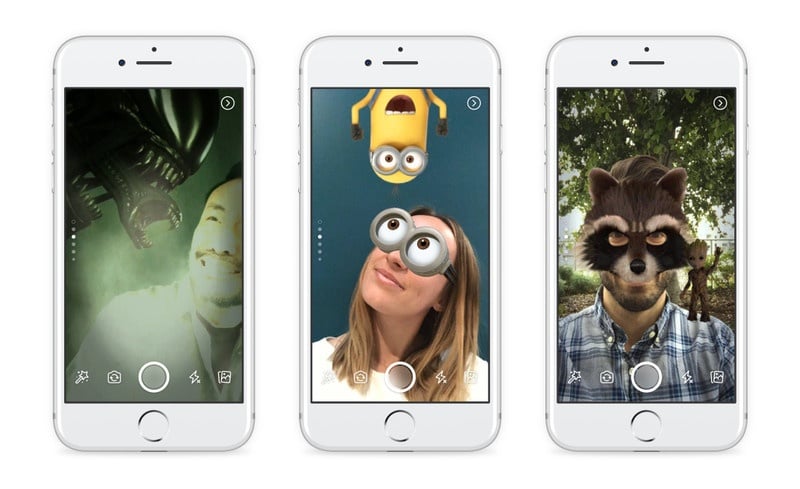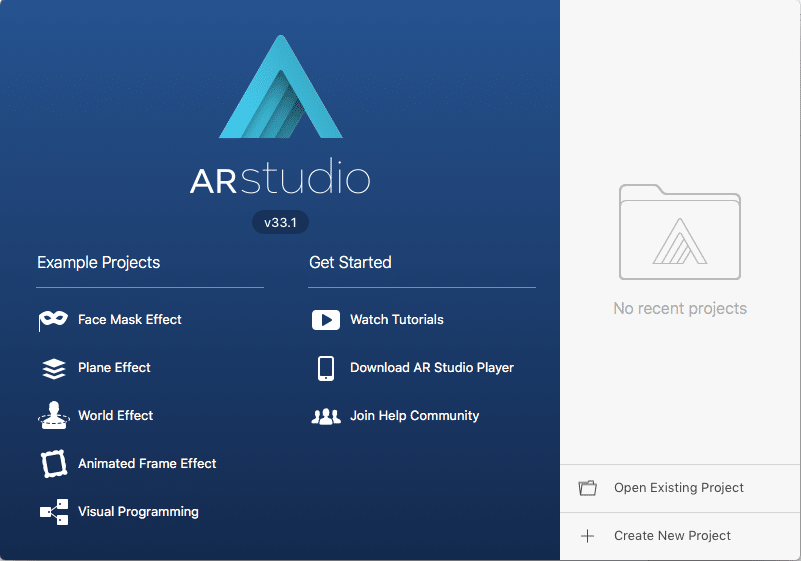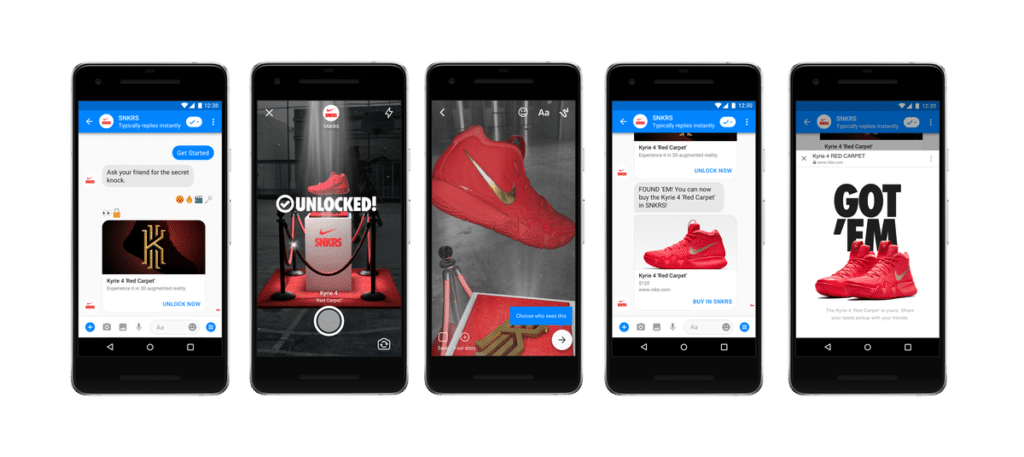If you’re new to our blog, this is a 3-parter. Check out Part 1, Augmented Reality Advertising on Snapchat. In this second post, we cover everything you need to know to launch an AR advertising campaign on Facebook. High level: Facebook AR advertising experiences are available in-app and on mobile web. The two major apps where brands can build and deploy AR creative are Facebook and Snapchat. An alternative to the walled gardens, the route with the greatest scale, and our bread and butter, is mobile web. Comprehensive AR campaigns may leverage all three. But how? And where to start? Not to worry, we’re here to help! In this three-part series, we’ll explain best practices for augmented reality advertising on Snapchat, Facebook, & Mobile Web, as well as how to use the same assets across platforms. And now for the good stuff: how to advertise in AR, this time on Facebook.
Facebook AR Advertising – How It Works
Facebook, similar to Snapchat, allows branded AR lenses within the Facebook, Instagram, and Messenger ecosystems. These include both front- and rear-facing camera experiences. Unlike Snapchat, brand access to sponsored lenses started purely as a content play, without any media-based distribution into the platform. This is great for creators looking to explore what works in AR, as Facebook has made it relatively easy from the start for users to create and deploy their own AR experiences. Upon activating branded lenses found in the camera carousel, marketers must rely on organic sharing and posting of their AR advertising experiences by Facebook users. At Facebook’s annual conference, F8 2018, the company announced numerous updates to its AR product. These include media-based opportunities for bot-delivered AR experiences in Messenger, thereby allowing marketers a more direct path to AR experiences as ads. Furthermore, Facebook just announced direct to AR media opportunities via the News Feed. But, more on that later.

A few examples of branded AR lenses on Facebook. Real quick! Check out more of our favorite AR ads, including Ready Play One, from Facebook, Snap, and the web.
AR Studio
Facebook launched its Camera Effects Platform in April 2017 which includes AR Studio, a self-serve toolkit, allowing artists and developers to build interactive AR experiences for both front- and rear-facing cameras. Originally released in closed beta to 2,000+ developers, AR Studio opened to the public in December 2017. As a result, this granted access to anyone looking to build and deploy AR experiences into the Facebook ecosystem, similar to Snapchat’s self-serve creator interface.

Interactive AR is a bit more complicated than just building 2d or even 3d creative. There are computer vision algorithms that make face mapping and tracking possible. Additionally, there’s sensor data that computes movement of the camera so that AR components respond accordingly. There are scripting APIs that adapt to user interactions in real time. An integration with Sketchfab is currently in the works (one of the many announcements at F8 this year), which will enable creators to search and select from Sketchfab’s library of 3d models within AR Studio. Also on the horizon is the ability for creators to upload their own custom 3d model libraries. Other significant improvements to AR Studio announced at F8 include:
-Visual programming optimizations, enabling creators to drag & drop custom elements into their scenes without using Javascript
-Updates to include body & hand tracking as well as high-fidelity face tracking
-Green screen capabilities
-Location-based AR (experiences accessible to users in a given location)
-Semantic scene understanding (tying AR reactions to triggers based on object recognition)
These updates not only improve the creator experience, they dynamically increase the potential for new mobile AR experiences we’ve never seen before, specifically around capabilities such as hand and body tracking.
Distribution
Branded AR experiences have not been served as ads in Facebook in the traditional sense. Currently, branded AR found directly in the camera carousel is treated solely as content. Most of the data brands receive around the performance of these lenses is based on organic distribution à la branded content within Facebook. This is similar to lenses created with Lens Studio on Snapchat (distributed via shared Snapcode or deep link URL).
Another route recently used by Warner Brothers to promote the release of their film, Ready Player One, is a printed QR code shared via a promotional poster. A unique marker-based AR experience was accessible to any user who scanned the poster with the Facebook camera. This format is available to AR Studio users too, thanks to the most recent update.
Additionally, an announcement out of F8 this year involves bot-delivered AR advertising experiences. Brands can drive users to AR experiences in Messenger via click-to-Messenger media placements in the Facebook News Feed and Instagram Feed. Upon tapping on these ads, a conversation with the brand’s bot will open in Messenger along with a prompt to explore a branded AR experience via the camera.

This was initially available to only a few select brands, such as Kia, Nike, and Sephora, and represents an opportunity for more lower-funnel AR marketing (direct response, for example), similar to Snapchat’s recent launch of “shoppable AR lenses”. Facebook’s most recent announcement, however, is true media-based distribution. Starting with a handful of brands, such as Michael Kors, AR experiences can be delivered directly from ads placed in the News Feed. This is a big deal as it turns what was a passive route to branded AR via bot delivery to a very short, very wide funnel. This announcement is essentially a Facebook stamp of approval for AR advertising. If you haven’t already, now might be a good time to jump on the augmented reality bandwagon.
Pricing
In terms of AR-specific pricing, Facebook’s Alpha program has thus far only offered a fully managed service that includes creative and media. As Facebook News Feed AR, Messenger AR, and eventually Instagram AR matures, we are likely to see this change to a more self-serve approach later in 2018 or early 2019. Facebook reported $39.9B in advertising revenue in 2017, driven by user activity and time spent across its apps (Facebook, Instagram, Messenger). The average user spends roughly 50 minutes per day across all three. While sponsored AR (in the camera carousel) on Facebook is essentially free to brands at the moment, the value to Facebook of hosting engaging AR advertising experiences is clear. With brands doing the heavy lifting to ensure new lenses appear regularly in the camera, users are more likely to keep coming back. This is especially the case when those lenses are attached to prominent brands with an already massive fanbase.
Data
In March of this year, Facebook announced improvements to the analytics brands can expect for AR ads on the platform. Advertisers can now see:
-# of Unique people to use a lens
-# of People who took a photo with a lens
-Whether an action was taken (purchase, install, webpage visit)
Previously, marketers only had access to the number of times a lens was used and the views it generated. While this is a significant improvement, it isn’t actually great, especially considering the numerous opportunities available for brand interaction data. This, of course, harkens back to our original reason for starting this post: how to use AR assets across Facebook, Snapchat, and mobile web. If not for the scale mobile web affords, do it for the data!
Ready for more? Check out the conclusion to this 3-part series: How to Advertise in AR on Mobile Web.
Not a current customer but ready to get started?
Demo the Platform Today!Already a current customer? Log in to Axis Today!

